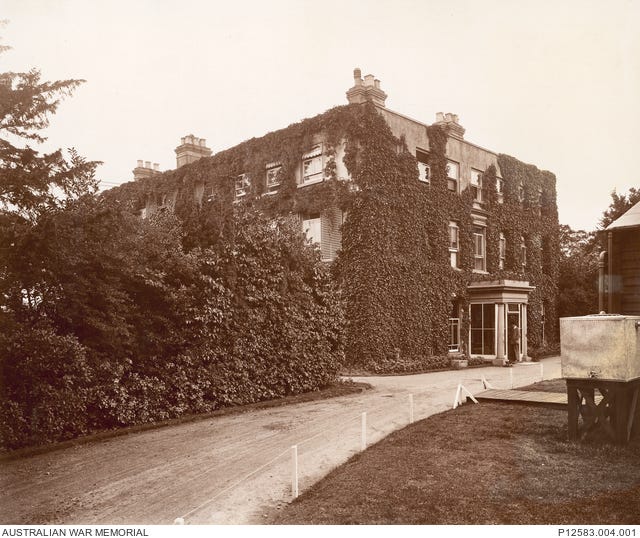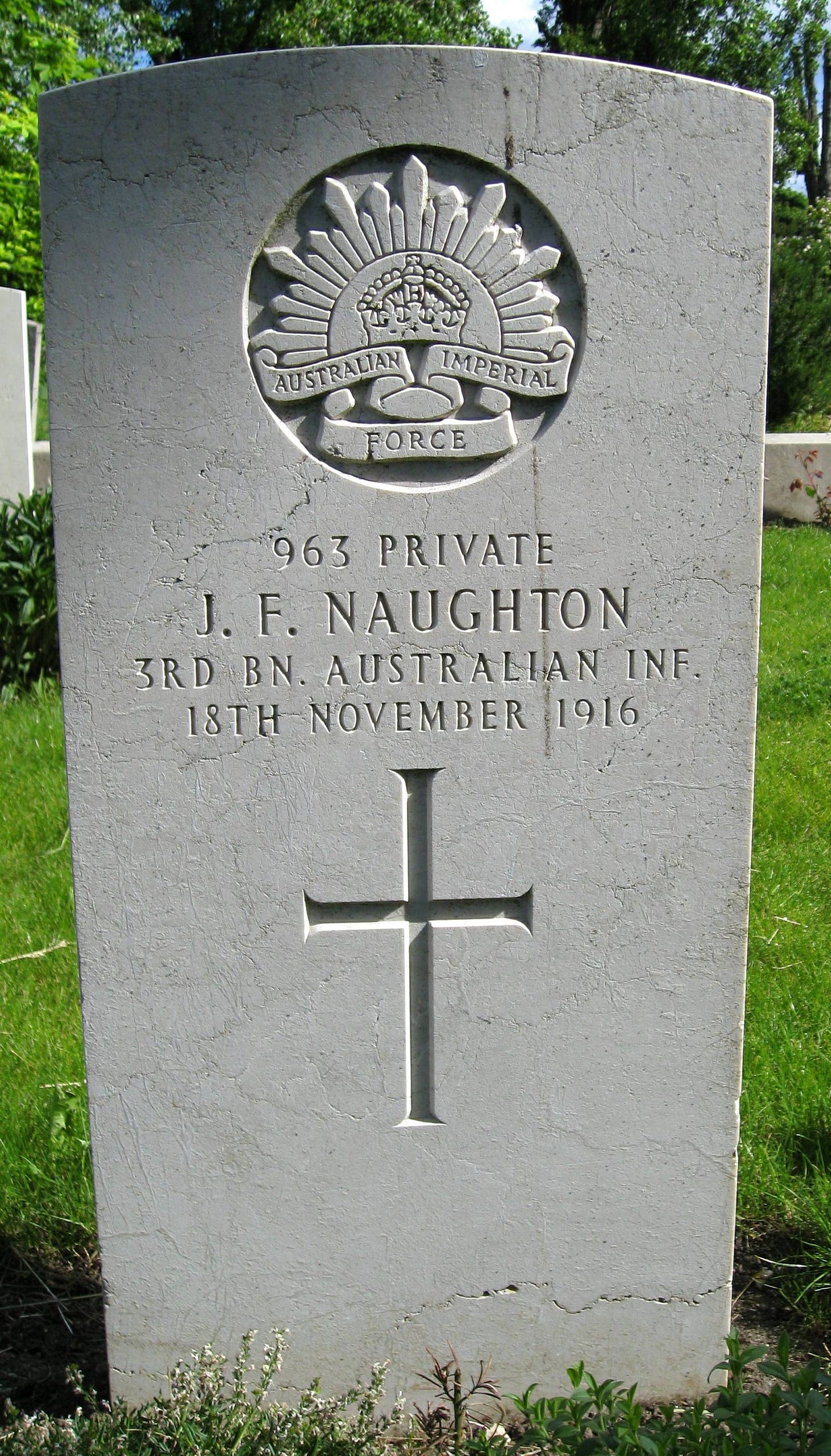Jack Naughton was twenty-eight-year-old baker who had recently lost his father when he signed up to the AIF in Sydney on 1 September 1914.1 Born in 1885 in Charters Towers, Queensland, he was one of twelve children of Thomas Naughton and Harriet Butler.2 Jack’s younger sister Clarice was married for sixteen years to Andrew Costello, my great grandfather Maurice Patrick’s brother, but they divorced and had no children. So, Jack is technically not my relative, but I found his war story so fascinating I wanted to tell it here.3

After six months basic training, Jack embarked Sydney on the Darlington in April 1915 to join the 3rd battalion in Gallipoli. His enlistment papers describe him as 5 feet 10 inches tall, weighing 11 stone 1 pound, with dark complexion, blue eyes and fair hair. Jack only saw four months of active service in Gallipoli before he was badly wounded; on August 15 a bomb exploded in his hands, necessitating their amputation, and wounded his right hip, thigh and knee. It is unclear from the records whether the amputation occurred in Gallipoli or in England. Two days later, on August 17, 1915, Jack was evacuated to England on the Mudros, and admitted to King George Hospital in Waterloo, London on August 30.4
Jack maintained his humour and was stoically determined to learn to live with his injuries. He taught himself to write and a letter home to his sister was published in the Charters Towers Evening Telegraph Friday 10 March 1916. It reveals much about Jack’s personality: he enjoyed being taken to music halls and the theatre, and taking tea with Ladies, and didn’t mind telling the young ladies what he thought of them smoking cigarettes!5
Lost Both Hands.
YET WRITES VERY WELL
TOWERS SOLDIER IN LONDON.
The following letter from Mr. Jack Naughton to his sister, Mrs. Worsfield, of Charters Towers, is of sad interest. Jack is a son of Mrs. Naughton, of Racecourse Road, and the family are extremely well known and highly respected, having carried on business here for the past thirty years. The writer enlisted at Bathurst and was sadly wounded at the Dardanelles, where he lost both hands, and it is doubtful if he will recover the use of one of his legs. Lady Robinson, (Agent-General's wife) is supplying him with artificial limbs, and other ladies have been more than kind to him in his misfortune. This letter is one of many he has written himself in spite of his infirmities, and all through he has never bemoaned his fate, and kept a stout heart, to the admiration of his new friends in Britain, and his old ones here.
He writes from King George Hospital, Stamford Street, Waterloo, London S.E., A. G. Ward, on January 8th:—Just a few lines to let you know that I am still alive and I received your letter and remittance all right. I have been out driving a lot, and to theatres, and I was at a music hall, called the Coliseum. Madame Sarah Bernhardt was acting; she is over seventy years of age, and she had a leg taken off. The place was crowded. It was a great honour to see a play like that, as there were thousands turned away. But they always make room for a wounded soldier. They took me up in a lift and then a man carried me on his back. Queen Alexandra and the Queen of Portugal were in a box just at the back of me, and we had tea in there with Lady Birdwood, and all eyes were turned on me, because I had to be fed and could not walk. The people are good here; they can't do enough for me. There is another lady I wish you would write to and thank—Mrs. E. Tuff, 4 Repley Buildings, Rushworth-street, London S.E. She has been very good to me, and she lost her husband in the war ten months ago. He is reported missing, but she has heard he is dead. She is a real good sort; cannot do enough for me. The doctor is going to fix me up with crutches; I have been trying to walk on crutches, and it is funny to see me holding them and getting along. I generally go to ladies' places for tea, and girls eighteen and over smoke cigarettes and the mother and father with us after tea. It looks terrible, but it is the fashion with the high ladies. I don't like it and I have told them. I said they ought to jump into trousers straight away. I am pretty good at writing now and it don't take me long to scribble a few lines.On 31 May 1916, after he had recovered, Jack was admitted to the 1st Australian Auxiliary Hospital, Harefield House, in Hillingdon, Greater London, where he would spend his convalescence.6 Built in the early 1700s by George Cooke, the chief prothonotary of the Court of Common Pleas, it was owned in the early 20th century by Australian expats Charles and Letitia Billyard-Leake. Their two sons had enlisted and they offered the house for AIF soldier rehabilitation in 1914. It was used as a convalescent hospital until 1919.7

Jack was discharged from the AIF due to his permanent disability (amputated hands and knee ankylosis) on May 23, 1916. It is unknown whether he ever received his prosthetic hands. He died November 18, 1916, in Fulham Military Hospital, Hammersmith, of Renal Calculus Nephritis Botany Inadequacy, which as far as I can determine, is kidney failure caused by kidney stones which doctors attributed to diet rather than his wounds. Jack was buried at Kensal Green Cemetery.8
But Jack’s story doesn’t end there. In September 2017 the Australian War Memorial put out a call for information about a photo in its possession of a young soldier sitting in a chair in a field. He appeared to be writing a letter by holding a pen between what was left of his forearms. It was taken at Harefield Auxiliary Hospital.9 A history teacher from Camden New South Wales took up the challenge. He found the letter written by Jack to his sister published in the Charters Towers Evening Telegraph.10 He also found another letter from a Rockhampton woman in England who wrote home about the central Queensland soldiers she had met in England, either on leave or in convalescent hospitals. It was published in the Rockhampton Morning Bulletin 27 July 1916:11
Central Queenslanders in England, letter from Mrs H G Wheeler
Mrs H G Wheeler, writing to Miss M S Trotman from London on the 19th of April, says … On Friday Mrs Hall very kindly drove me out to Harefield Park Hospital … Naughton, the Charters Towers boy, is also there waiting for his hands to be fitted. His thigh is sufficiently healed to allow him to walk a little without crutches.The teacher then tracked down two of Jack’s living relatives using online genealogy: a great-niece living in Tasmania, and a great granddaughter of his aunt living in Gordonvale, Queensland. She supplied the first photo in this post that she had inherited from her mother.12 Professor Bruce Scates from the Australian National University's School of History told the ABC that Jack suffered indignity in death:
He was buried initially in an open grave … there were just so many casualties, we couldn't keep pace with the number of men dying in the hospitals. Up until 1917 we were still burying [soldiers] en masse. The only people who got individual graves were officers, and nurses, who are honorary officers. Other than that, men were often buried in pits.13
According to Scates, Jack’s body was left exposed at Kensal Green Cemetery in London for weeks and the grave was only covered after protests from Australian expatriates, and in 1921, he was exhumed and placed in a separate plot for Australian soldiers. This photo has now been added to Jack’s entry on the Australian War Memorial’s online Roll of Honour, where it belongs.14

Service records for John Francis Naughton, First Australian Imperial Force Personnel Dossiers, 1914–1920, National Archives of Australia, B2455, NAUGHTON/John Francis, p 1; Death registration of Thomas Naughton, died 21 June 1914, Birth, Deaths and Marriages, Queensland, 1914/C/2359.
Birth registration of John Francis Naughton, born 6 October 1885, Births, Deaths and Marriages, Queensland, 1885/C/4799.
Marriage registration of Andrew Joseph Costello and Clarice Katherine Naughton, married 17 September 1913, Australia Marriage Index, 1788-1950, Ancestry.com.
Service records for John Francis Naughton, p 3, 18, 22.
Evening Telegraph (Charters Towers, Qld. : 1901 - 1921), Friday 10 March 1916, page 5, National Library of Australia, http://nla.gov.au/nla.news-article212810616.
Service records for John Francis Naughton, p 18.
World War 1, Europe, England, Harefield, 1 Australian Auxiliary Hospital, 1917, Collections WA, Western Australian Museum, https://collectionswa.net.au/items/ea28cd74-a894-4673-b74d-7f783ba1dbea#; Bec Whetham, 2021, Letitia Leake used $40m inheritance to help 50,000 wounded Anzacs during WWI, https://www.abc.net.au/news/2021-04-23/glencoe-heiress-who-ran-anzac-hospital-in-uk/100055656
Service records for John Francis Naughton, p 27.
Tegan Osborne and Claire Wright, 2017, Do you know this amputee Anzac? The Australian War Memorial wants your help, Australian Broadcasting Commission, https://www.abc.net.au/news/2017-09-15/do-you-know-who-this-wounded-anzac-australian-war-memorial/8893066.
Tegan Osborne, War Memorial's wounded Anzac mystery unravelled by high school history teacher, 2017, Australian Broadcasting Commission, https://www.abc.net.au/news/2017-10-28/history-teacher-helps-solve-anzac-amputee-mystery/9089394.
Morning Bulletin (Rockhampton, Qld. : 1878 - 1954) Thu 27 July 1916, p 5, National Library of Australia, https://trove.nla.gov.au/newspaper/article/53382947#.
Tegan Osborne, War Memorial's wounded Anzac mystery unravelled by high school history teacher, 2017.
Bruce Scates in Tegan Osborne, War Memorial’s wounded Anzac mystery unravelled by high school history teacher, 2017.
Tegan Osborne, War Memorial’s wounded Anzac mystery unravelled by high school history teacher, 2017.





What an amazing story. Its sad that he didn’t live long after his injuries. With such a positive attitude, he would have inspired many.
This is an amazing story. It seems somewhat ironic and particularly sad that his cause of death related to complications due to a bad diet.